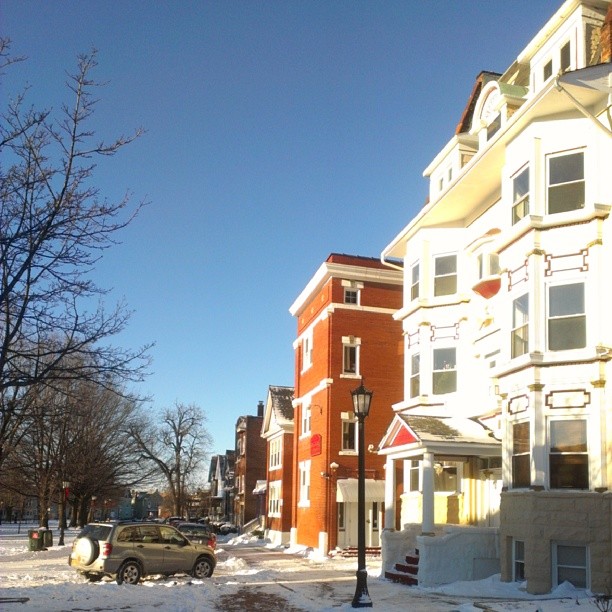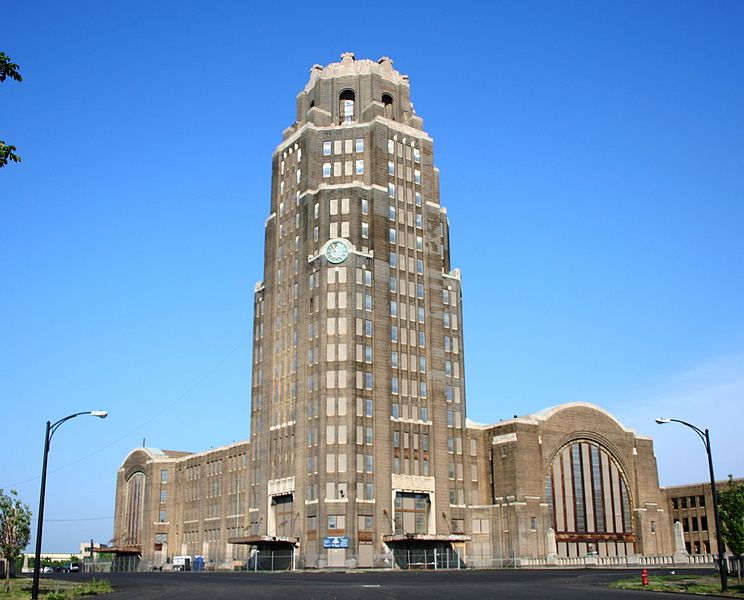Back in December, the Washington Post published a completely arbitrary list of what was in for 2014 and out for 2013. In addition to ridiculously passé things such as Russia and food stamps, Austin was also considered “out” for 2013. In its place? Buffalo, Mother-f’ing New York.
Oh, how I laughed!
How could Buffalo, New York, the city where a person’s umbilical cord freezes instantly upon exiting the womb, be the new “it” city?
Being from Upstate New York and having been to Buffalo several times as a child, I was confused by this tomfoolery. As far as I knew, Buffalo, much like where I grew up, was a sad city far past its prime. It was where dreams go to die in four feet of snow with a mask covering its frowning, pale face.
So, as punishment for erroneously poo-pooing Buffalo, the powers that be decided to strand me there over the holidays. I was traveling back to Austin by train, bus and car – ANYTHING TO AVOID THOSE FLYING DEATH TUBES!!! – and I found myself stuck for one night in Buffalo due to the weather. Tired and cold, I thought that I was going to have sleep in the bus terminal overnight (remember Adventures in Babysitting?), but an acquaintance-now-friend came to my rescue and let me crash on his couch.
And for the 14 hours I was in Buffalo, I became a believvvver. A buffaliever, if you will. Abelievuffalo. Though comparing Austin to Buffalo is like comparing a heat-stroked apple to a freezer-burnt orange, they both have their individual charm and equally deserve recognition. The most notable difference between the two cities is that Austin has been highly discovered by both citizens and developers over the past ten years. Development is rampant and the economy is booming. Buffalo, on the other hand, is seeking and encouraging development in order to boost their economy. Because of Buffalo’s infrastructure, architecture and culture, it has ample grounds for a renaissance.
If you’re into architecture and urban planning, Buffalo will make you concrete in your pants. Start by watching this video about how Buffalo is one of the nation’s best designed cities.
[youtube http://www.youtube.com/watch?v=sBsi5FGbY2Y%5D
Are you crying yet?
If you were a lazy ass and didn’t watch the video, Buffalo was designed by the brother of an architect on the team that designed D.C., and the city has a unique radial layout that created beautiful neighborhoods unlike most other major cities in the U.S. Buffalo also has a park and parkways system inspired by Paris, France, that boasts close to 30 green recreational spaces (there is nothing really hipster about radial grids and parks, but let’s face it, I just use the term “hipster” to talk about cool cities that I love).
The video also goes on to discuss the city’s adaptive reuse of the Larkin Soap Factory (see below) and the Buffalo architecture by the ”trinity of American architecture:” Frank Lloyd Wright, Henry Hobson Richardson and Louis Sullivan. The aforementioned Larkin Soap Factory included a gorgeous Frank Lloyd Wright administration building that was torn down! See the photo of it here.
I’ll admit that I was crying like a weak child by the end of the video. Because I’m from the Rust Belt (I grew up in a small, economically-depressed town two and a half hours southeast of Buffalo), I have a strong attachment to the majestic cities that now sit like outcasts in the shadows of cities, say, like Austin. But that is soon to change!
My friend, a native Buffalonian who returned to his city a few years ago, lives in the historic Allentown Neighborhood, a vibrant area filled with historic architecture, mom-&-pop businesses, coffee shops, music venues and beautiful parks filled with public art. Read this Allentown blogger’s views on the neighborhood he lives in to get an idea of how cool the area is. If you blindfolded me and dropped me in Allentown, I would think I was in New York City.
I was told that The Old Pink is a good dive bar to check out in this neighborhood, and we stopped in Cafe Taza, a hole-in-the-wall whose less than ten seats inside and out lends well for making new friends and conversation.
Elmwood Village is another area popular with diverse communities, and the Wikipedia entry for Elmwood Village states that Cole’s, a neighborhood restaurant and bar, was one of the first gay-friendly bars in the U.S. during the 1920s. This neighborhood, filled with many of Buffalo’s popular Victoria homes, was also named one of the best places in the U.S. by the American Planning Association.

Photo by Lauren Modery
Since Buffalo was at one point one of the top ten most populated cities in America, it now has the slight characteristics of Detroit, speckled with gorgeous, vacant architecture (a.k.a. ruin porn). As my train rolled into the station the night I was stranded, I noticed a giant, dimly-lit Art Deco compound out on the horizon. I asked my friend what it was, and he told me it was the Buffalo Central Terminal, built in 1929. Abandoned in 1979, the building has had an interesting life in the past four decades, one filled with owners stripping it of its beauty and selling pieces off and a passionate community buying those pieces back and hoping to restore the looming beauty. There is talk about making the building suitable for public use in the near future, and several commercials and videos have been shot here.

Photo by Dave Pape
A similar story goes for the mammoth Richardson Olmsted Complex, otherwise known as the Buffalo State Hospital. Designed by Henry Hobson Richardson (mentioned above), this building was also abandoned in segments over the past few decades and work on redeveloping the area as a hotel has begun.
A good example of what Buffalo can do with its abandoned buildings is Larkin Square. The former home of the Larkin Soap Company, this Downtown area now boasts food trucks, concerts and community events.
Ok, ruin pornographers. I have one last drool-worthy architecture to gush about: Buffalo’s grain silos. Part of what made Buffalo a thriving city during the 1800s and early-1900s, these abandoned stalwarts are now used for rock climbing, kayaking and paddle boarding and art shows. Check out this Atlantic Cities article on plans to create an illumination show at the silos.
Buffalo is a walkable city, but as my friend tells me, it wasn’t until recent that it became a bike-friendly city. Bike lanes are starting to pop up more and more from the help of citizen action and Go Bike Buffalo. Due to the intricate parks and parkways system mentioned above, there are several green spaces for citizens to walk, run, bike and play in. The cost of living is relatively low, with one bedroom rentals averaging around $779 and two bedroom rentals averaging around $1116. For those who want to get out of the city often, you’re an hour and a half drive to Toronto, and there are direct train rides and buses to New York City. From what I’ve gathered, Buffalonians love their city, and they want to see it succeed. Many natives are moving back, bringing their unique ideas with them. Buffalo is changing, and there is too much going on to even write about here (read about plans for their Erie Canal waterfront). Maybe the change is not quick, but as we’ve seen from Austin, quick is not always the best answer. This city is bubbling with the energy of something new just around the corner.
So, what about that giant, snow-covered elephant in the room? Yes, Buffalo can be very cold, but who really cares? The man-made weather apocalypse is coming soon anyways; why not live in an interesting city while you still can? ![]()
This post originally appeared at Hipstercrite.





